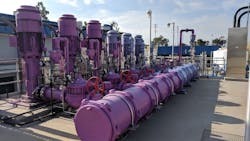What is potable water?
Potable water is also known as drinking water and comes from surface water and groundwater sources. This water is treated to levels that meet state and federal standards for consumption.
There are two main methods for converting wastewater to potable water: indirect potable reuse (IPR) and direct potable reuse (DPR).
Potable reuse requires the careful monitoring of pathogens and chemical contaminants due to its higher concentrations in source water.
What is Indirect Potable Reuse?
Indirect potable reuse involves release of treated wastewater into a strategic environmental source, including a reservoir or aquifer for a specified period of time before being withdrawn for potable purposes.
One of the earliest uses of indirect potable reuse was in 1962 in Los Angeles County Sanitation District’s Montebello Forebay project.
What is Direct Potable Reuse?
In direct potable reuse, purified wastewater is directly introduced into the raw water supply feeding a water treatment plant without the use of an environmental buffer.
What is Potable Water Used For?
The U.S. EPA and other industry associations maintain that potable reuse of water can help states, tribes, and communities meet their future drinking water needs as noted in the EPA 2017 Potable Reuse Compendium.
Potable reuse is expected to grow in the coming decades, according to a report from Bluefield Research 2015. The report estimates that by 2025, municipal utilities’ wastewater reuse will increase by 61%.
Why is it Called Potable Water?
Potable comes from the Latin potare, meaning "to drink." The Romans came up with the word and built some of the world's first aqueducts, above-ground channels that brought potable water from the mountains to the cities.
What is Non-potable Water Reuse?
Water for non-potable reuse generally does not require the same level of treatment as potable reuse. Non-potable reuse is water not intended for direct human consumption.
Non-potable water sources include rainwater, grey water, reclaimed water and recycled water, among others.
Centralized non-potable reuse requires pipe networks and pumping systems or an alternate delivery system. Purple pipe infrastructure is mandatory in non-potable reuse applications to distinguish non-potable water lines from others. The purple color provides clear markings for this so non-potable and potable lines do not cross.
Ultimately, water reuse may include a combination of potable and nonpotable uses to increase water supply resiliency.
What is De Facto Reuse?
De facto reuse is when reuse of treated wastewater is practiced, but is not officially recognized. For instance, a drinking water supply intake located downstream from a wastewater treatment plant discharge point is considered de facto reuse.
Although de facto reuse locations yield potable water that meets current drinking water regulations, many wastewater impacted source waters in de facto potable reuse locations receive less monitoring and treatment prior to entering the water supply.
